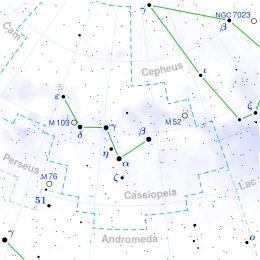5 Andromedae
| Observation data Epoch J2000 Equinox J2000 | |
|---|---|
| Constellation | Andromeda[1] |
| Right ascension | 23h 07m 45.38355s[2] |
| Declination | +49° 17′ 44.7904″[2] |
| Apparent magnitude (V) | 5.68[1] |
| Characteristics | |
| Spectral type | F5 V[3] |
| B−V color index | 0.449±0.003[1] |
| Astrometry | |
| Radial velocity (Rv) | −2.6±0.3[1] km/s |
| Proper motion (μ) | RA: 151.592(34) mas/yr[2] Dec.: 131.723(31) mas/yr[2] |
| Parallax (π) | 29.0956±0.0408 mas[2] |
| Distance | 112.1 ± 0.2 ly (34.37 ± 0.05 pc) |
| Absolute magnitude (MV) | 3.00[1] |
| Details[4] | |
| Mass | 1.386+0.010 −0.009 M☉ |
| Radius | 1.741[5] R☉ |
| Luminosity | 5.62[1] L☉ |
| Surface gravity (log g) | 4.12±0.02 cgs |
| Temperature | 6,605±61 K |
| Metallicity [Fe/H] | −0.09±0.05 dex |
| Rotational velocity (v sin i) | 9.7[6] km/s |
| Age | 2.28+0.12 −0.25 Gyr |
| Other designations | |
| 5 And, BD+48°3944, FK5 1604, HD 218470, HIP 114210, HR 8805, SAO 52713, PPM 63843[7] | |
| Database references | |
| SIMBAD | data |
5 Andromedae is a single,[8] yellow-white hued star in the northern constellation of Andromeda, abbreviated 5 And.[1] Its designation comes from a catalogue of stars by English astronomer John Flamsteed, published in 1712. The star is faintly visible to the naked eye, having an apparent visual magnitude of 5.68.[1] Based upon an annual parallax shift of 29.1[2] mas as seen from Earth, it is located 112 light years away. 5 Andromedae is moving closer to the Sun with a radial velocity of −2.6 km/s.[1] It has a relatively high proper motion, advancing across the celestial sphere at the rate of 0.201 arc seconds per year.[9]
This is an ordinary F-type main-sequence star with a stellar classification of F5 V.[3] It is estimated to be 2.3[4] billion years old and is spinning with a projected rotational velocity of 9.7 km/s.[6] The star has 1.39[4] times the mass of the Sun and 1.74 times the Sun's radius.[5] It is radiating 5.6[1] times the Sun's luminosity from its photosphere at an effective temperature of about 6,605 K.[4]
Within Andromeda it is the second of a northerly chain asterism – 7, 8, 11 are further south-westward, with 3 Andromedae in the other direction.
References
[edit]- ^ a b c d e f g h i j Anderson, E.; Francis, Ch. (2012), "XHIP: An extended hipparcos compilation", Astronomy Letters, 38 (5): 331, arXiv:1108.4971, Bibcode:2012AstL...38..331A, doi:10.1134/S1063773712050015, S2CID 119257644.
- ^ a b c d e Brown, A. G. A.; et al. (Gaia collaboration) (2021). "Gaia Early Data Release 3: Summary of the contents and survey properties". Astronomy & Astrophysics. 649: A1. arXiv:2012.01533. Bibcode:2021A&A...649A...1G. doi:10.1051/0004-6361/202039657. S2CID 227254300. (Erratum: doi:10.1051/0004-6361/202039657e). Gaia EDR3 record for this source at VizieR.
- ^ a b Cowley, Anne; Fraquelli, Dorothy (February 1974), "MK Spectral Types for Some Bright F Stars", Publications of the Astronomical Society of the Pacific, 86 (509): 70, Bibcode:1974PASP...86...70C, doi:10.1086/129562.
- ^ a b c d Ramírez, I.; et al. (February 2013), "Oxygen abundances in nearby FGK stars and the galactic chemical evolution of the local disk and halo", The Astrophysical Journal, 764 (1): 78, arXiv:1301.1582, Bibcode:2013ApJ...764...78R, doi:10.1088/0004-637X/764/1/78, S2CID 118751608.
- ^ a b Schofield, Mathew; et al. (2019), "The Asteroseismic Target List for Solar-like Oscillators Observed in 2 minute Cadence with the Transiting Exoplanet Survey Satellite", The Astrophysical Journal Supplement Series, 241 (1): 12, arXiv:1901.10148, Bibcode:2019ApJS..241...12S, doi:10.3847/1538-4365/ab04f5, S2CID 119481586.
- ^ a b Schröder, C.; Reiners, Ansgar; Schmitt, Jürgen H. M. M. (January 2009), "Ca II HK emission in rapidly rotating stars. Evidence for an onset of the solar-type dynamo" (PDF), Astronomy and Astrophysics, 493 (3): 1099–1107, Bibcode:2009A&A...493.1099S, doi:10.1051/0004-6361:200810377[permanent dead link]
- ^ "5 And". SIMBAD. Centre de données astronomiques de Strasbourg. Retrieved 2018-01-31.
- ^ Eggleton, P. P.; Tokovinin, A. A. (September 2008), "A catalogue of multiplicity among bright stellar systems", Monthly Notices of the Royal Astronomical Society, 389 (2): 869–879, arXiv:0806.2878, Bibcode:2008MNRAS.389..869E, doi:10.1111/j.1365-2966.2008.13596.x, S2CID 14878976.
- ^ Lépine, Sébastien; Shara, Michael M. (March 2005), "A Catalog of Northern Stars with Annual Proper Motions Larger than 0.15" (LSPM-NORTH Catalog)", The Astronomical Journal, 129 (3): 1483–1522, arXiv:astro-ph/0412070, Bibcode:2005AJ....129.1483L, doi:10.1086/427854, S2CID 2603568.


 French
French Deutsch
Deutsch